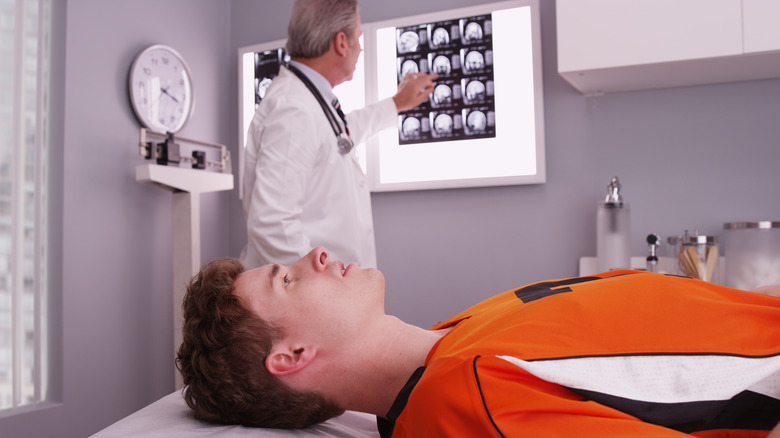How Are Concussions Different From Whiplash?
While whiplash and concussions may both happen at the same time and manifest similar symptoms post-injury, there are some important distinctions to keep in mind, particularly when it comes to treatment and monitoring. Whiplash is a neck strain that occurs as a result of a sudden or forceful back-and-forth movement of the neck and head, according to AICA Orthopedics. The most common cause of whiplash is a car accident, particularly a rear-end collision. However, it can also happen while playing sports, experiencing a traumatic fall, or as a result of physical abuse (via Mayo Clinic).
While whiplash occurs because of impacts to the neck, it's not just neck pain that can occur as a result. Per the Mayo Clinic, other symptoms include headaches, shoulder pain, and arm tingling or numbness, which may occur and develop over the course of hours and days after impact. Minor whiplash can be treated with proper interventions like ice, painkiller medication, and rest. More moderate whiplash cases may require a neck brace, massage, or, in serious cases, surgery (via AICA Orthopedics). Stretching and neck movement exercises as prescribed by your doctor may also alleviate whiplash, per Mayo Clinic. It's important to always speak with your doctor to get ongoing treatment and support as needed.
If you may be experiencing domestic violence, please know you can always reach out to the National Domestic Violence Hotline for help by calling 1-800-799-SAFE (7233).
Concussions can be serious
A concussion can be far more serious than whiplash and is actually considered a traumatic brain injury (TBI). It's usually incurred by a hit or blow to the head that causes the brain to move rapidly in the skull (via CDC). This kind of movement can actually create lasting chemical changes including damaged brain cells, per CDC, and is why boxing and rugby make the list of worst sports for your health.
While the effects of a concussion may be serious, they're usually not life-threatening and will resolve over time. However, in rare cases, blood can form on the brain, squeezing the brain against the skull, a life-threatening emergency in which 9-1-1 should be called immediately, per the CDC. Danger signs needing prompt medical attention include one pupil larger than the other, drowsiness or inability to wake up, a headache that gets worse and does not go away, slurred speech, weakness, numbness or decreased coordination, repeated vomiting or nausea, convulsions or seizures (shaking or twitching), unusual behavior, increased confusion, restlessness or agitation, and loss of consciousness, according to CDC.
Getting the proper care
Symptoms of whiplash overlap with symptoms of concussions, like a headache, for instance. But concussions tend to have cognitive manifestations such as confusion, mood changes, memory problems, and sluggishness, via AICA. However, it's particularly important to seek the right medical care if you suspect a concussion. An individual should first be evaluated in an emergency room and referred to a neurotrauma specialist; as a follow-up, a patient may be evaluated by a neurologist, neurosurgeon, or neuropsychologist (via Weill Cornell Brain and Spine Center).
Imaging scans can help determine the best course of action for treatment, depending on whether it's a concussion or whiplash. If the injury is a concussion, most recover within a few weeks with rest and a gradual return to daily activities. Symptoms that last longer may be indicative of Post-Concussive Syndrome, lasting weeks or months after the injury has occurred. It's important to address ongoing symptoms with your medical provider so that they know how to recommend the best course of treatment moving forward. Worsening symptoms in children and teens should be treated by emergency care, via CDC.



